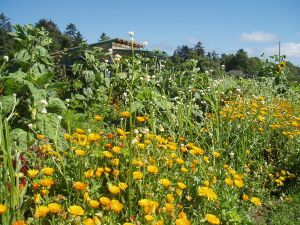
The following information is a demonstration of personal experience gained from two years of working at the Arcata Educational Farm. The Arcata Educational Farm has existed as a non-profit organization for the past 15 years with a fully functional CSA which doubles in providing the community with a direct educational experience in small scale vegetable production. Bayside Park is located at 930 Old Arcata Rd. Arcata, CA 95521.
My experiences over the last two growing seasons related to small scale community agriculture have taught me many important lessons pertaining to vegetable production in coastal northern California. I have organized the information presented in an attempt to mimic processes of production on the farm. From creating a potting soil to plant propagation to bed preparation/soil management to soil fertility to irrigation to cover crops/green manures to crop rotation/garden planning I try to touch on each basic step necessary for growing vegetables while maintaining a healthy farm. Also, in the following I touch on certain agricultural practices which set small scale community agriculture apart from its antitheses found in large scale agribusiness. Techniques such as composting, crop rotation, planting green manures and rotating crops with proper garden planning with low-input systems are all fundamental pillars of healthy agricultural operations.
As a disclaimer, I do not claim to be an expert in community agriculture. My knowledge on the subject is an evolving process. The majority of my education has come from direct engagement in the fields and in the community, not from teachers and textbooks. Additionally, it is my personal belief that farming is a lifelong learning venture. Two seasons at the Arcata Educational Farm has provided me with a bounty of knowledge related to many subjects spanning many disciplines. Skills such as educational outreach, community organizing, farm management, marketing and straight-up physical labor are all skills I have learned through the processes of vegetable production. My advice to anybody who is interested in learning how to grow food for themselves and the community is to get your hands dirty. The more direct experience with the land the better.
Potting Soil[edit | edit source]
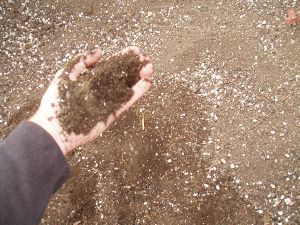
One of the first things done on the farm each year is creating a soil mix. Combining the correct materials for a soil mixture is extremely important in small scale agriculture. The soil mixture is mostly used for plant propagation in a greenhouse. Starting plants in a greenhouse has a number of advantages (for further information see transplanting section). For convenience purposes, many farmers in our area buy bagged soil. At the Arcata Educational Farm, we do our best to utilize compost on site as a source of fertility. Our basic soil mixture consists of several components. These include: sifted compost, spent soil, perlite, peat moss, and lime.
Sifted Compost[edit | edit source]

On site composting is a huge factor in sustainable agriculture. For a guide on how to build a compost pile visit Composting. A healthy farm should be able to produce some source of fertility through excess green and brown materials. For the preparation of the soil mix, we sift compost through a screen to collect the finer material. This allows the finished product to obtain a fine, consistent quality.
A disadvantage to using compost on site is weed germination in the potting soil. If a compost pile is exposed to weed seed this can lead to unwanted weeding of flats during seed propagation. Maintaining a proper composting system will eliminate this problem.
Spent Soil[edit | edit source]
Once a specific amount of compost has been sifted into the soil mix box, soil which has already been used in previous plant propagation is then added. Since previous vegetable starts have already used a certain amount of nutrients in the spent soil, the compost which has been sifted will add any additional fertilization necessary for the next succession. At the Arcata Educational Farm our generally agreed upon ratio for spent soil to sifted compost is 2:1.
Amendments[edit | edit source]
Compost and spent soil are the two major components of the soil mixture. However, some more amendments are necessary to establish a finished product. Perlite is a porous material that adds structure to the soil mix while allowing water to disperse evenly throughout the soil. Generally, spent soil already contains a certain amount of perlite. Because of this, we judge on a case by case scenario how much our soil mix needs. In a rough estimation, we throw in about 4 to 5 handfuls of perlite into the potting soil per wheel barrel. Another amendment used in our soil mix is peat moss. Peat moss adds to the structure of the soil by increasing the soil's capacity to hold water. The peat moss is sifted into the soil mixture (a couple hand fills per wheel barrel of spent soil is typically all that is needed). The last amendment we add to every soil mixture is lime. The knowledge was passed down to us by past farmers of the Arcata Educational Farm that the soil is slightly acidic. Lime is a basic, so the addition to our soil mixture evens out the pH. Amendments will vary depending on the soil quality of specific sites.
After all the above ingredients are added to our soil box, we then mix thoroughly. With a soil mixture complete, we are able to propagate in the greenhouse.
Plant Propagation[edit | edit source]
At the Arcata Educational Farm we order most of our seeds from Johnny's Selected Seeds. From seed to fruit it is important to follow certain processes in order to propagate healthy plants. Much of the information needed to adhere to specific plant demands such as spacing, depth, heat requirements, water requirements etc... can be found on seed packets.
For our purposes I am dividing plant propagation into two methods; transplanting and direct sowing.
Transplanting[edit | edit source]
Once a soil mix has been made, the soil is then added to a flat. A flat is essentially a temporary growing space for a seedling. There is a number of different styles of flats made out of materials such a wood, plastic and Styrofoam. Flats are often either divided into cells for each individual seed or left open. Different styles of flats have certain advantages and disadvantages. For example, our wooden flats are made sturdier and hold more soil and more water than plastic flats, allowing more root space for the seedling. However, wooden flats are heavier than plastic flats and this makes them more difficult to transport out to the field. An advantage to flats which are divided into cells is the convenience gained for transplanting. Since each cell contains one plant no time is lost digging through the flat and separating individual starts. Cells are also advantageous in that the roots of a start are damaged less through the process of transplanting. However, the amount of root space is limited in cells, and as a result the transplanting window is less than that of an open flat. Additionally, starts left in cells for too long may become root bound and stunted.
Inside the flat, seeds are planted with appropriate space and depth. The flat must be watered and tended until the start has reached an appropriate size for transplanting. A good rule of thumb in determining whether or not a start is ready to transplant is by waiting until the first two true leaves appear. When the start has become big enough to put outside, the next step is to harden-off.
Hardening off is done by placing the start outside where it is exposed to the elements (i.e. wind, rain, etc…). This technique allows the plant to become stronger before it is planted out in the garden.
-
Flat variations
-
Julie Jo sowing lettuce seeds into a flat filled with potting mix
-
Veggie starts
-
Starts hardening off in flats outside of the main greenhouse
-
Transplanting cabbage out in the fields
-
Established transplants
- Advantages
-
- Transplanted crops have a head start on weeds
- High germination rates inside a greenhouse
- Extend the growing season by starting plants inside before weather would permit them to grow outside
- Disadvantages
-
- Compared to direct sowing, transplanting individual starts is time consuming and labor intensive
- Not all crops are able to be transplanted. Root crops such as carrots and beets are damaged when transplanted. Leafy mixes such arugula, mizuna, leaf lettuce are better off directly sown.
- Plants undergo a transplant shock when moved from the flat to the field. This can occur from the move from greenhouse to outdoors; a controlled micro-climate to an immersion into the elements. There is also shock due to root damage. This can be avoided by transplanting in the evening and giving plenty of water and fertilization (i.e composted chicken manure or fish emulsion) to allow roots to settle.
Direct Sowing[edit | edit source]
The other method for getting a desired crop to grow is planting the seed directly in the soil. Once a piece of land has been properly prepared for planting (see field preparation) the seed may be planted at the proper depth and spacing. At the Arcata Educational Farm we use a device known as the seed drill. The seed drill operates using different sized plates corresponding to seed size. When the drill is pushed along a bed, the plates spin and seeds are dropped into the soil at the appropriate spacing and depth.
-
This part of the seed drill controls the depth
-
Inside the seed hopper a plate with various size hole and spacing controls the seed spacing as the drill is pushed and the plate rotates
-
Drilling peas into the soil
- Advantage
-
- With the help of a seed drill, this method takes less initial planting time and labor than transplanting
- Disadvantages
-
- More labor is spent weeding and thinning these crops. Sowing seeds directly into the soil gives weeds a chance to out compete the desired crop. Thinning is especially crucial because the seed drill tends to bunch seeds together. Thinning gives the crop the appropriate space it needs to grow to its full potential.
- Not a consistent rate of germination. As compared to transplanting where starts are propagated in the protection of the greenhouse, seeds sown directly into beds are more susceptible to damage from pests, weather and any other possible deterrents to its growth.
- Field must be more thoroughly prepared (i.e. tilled finer). The finer the tilth the more efficient the seed drill is.
Bed Preparation/Soil Management[edit | edit source]
In preparing the soil for planting crops one must create an ideal growing space while at the same time retaining the soils ability to hold nutrients (i.e. fertility). A term used to describe the condition of the soil is tilth. A soil with optimal tilth has factors such as finely structured pieces of soil, pore space, rooting depth and drainage. Tilth can be achieved in a number of different ways depending on tools and the amount of space one is cultivating.
Home Garden Scale[edit | edit source]
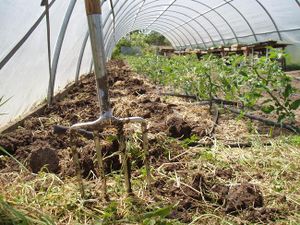

To achieve an ideal tilth in a home garden the best tools for the job are a spading fork, hoe and rake. When the soil has reached a state where it is appropriate to cultivate, a spading fork can be used to loosen the top 8-12 inches of soil. Next, the hoe is used to chop up dirt clods into a fine consistency. Lastly, the rake is used to provide a desired bed shape. Shaping a bed with a flat surface on top and curved edges helps water percolate down into the crop instead of creating unwanted run off.
Small Farm Scale[edit | edit source]

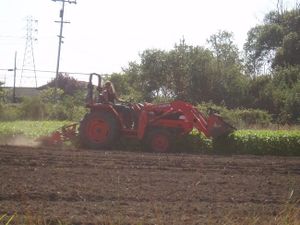
When working a piece of land larger than a home garden, certain machinery can drastically reduce the hours of labor spent in bed preparation. With a lawn mower and roto-tiller, one can effectively cultivate a couple acres. The lawn mower is used to chop down any existing organic material (either a cover crop/green manure or grass/weeds). After the land is mowed down to a stubble, a roto-tiller can break up the soil to a desired depth for planting. In between a mowing and tilling, I have found it very helpful to use a spading fork to work the soil. This creates depth as well as helps bring oxygen into the soil to fuel micro-biotic activity.
The next step up after a lawn mower and roto-tiller is a tractor and its various implements. Tractors can be used to plow, disc, till, mow, seed, etc… Most of my personal experience in agriculture has not utilized any other function of a tractor other than mowing and tilling. What I have learned is that tractors can replace farmers by the handfuls in terms of labor output in breaking the soil. However, nothing can replace the knowledge involved with responsible land stewardship. The larger the farm, the more likely it will be highly mechanized and dependent on finite resources which are the foundation of wars and the cause of the rapid deterioration of our habitable environment. As a side note, it is my belief that local food production provides an alternative to destructive cycles with-in our social organization. This is why I believe it is important to support small scale, labor intensive community sustained agriculture.
Soil Moisture[edit | edit source]
Whether working a small home garden plot or a larger piece of land, soil moisture is paramount in deciphering when to start breaking the soil and working the land. Tilling a piece of land when it is too wet is one of the best ways to absolutely destroy all of the qualities associated with an ideal tilth. The compaction caused by working a soil before it is dry enough can cause severe problems with aeration, drainage, rooting depth, in a word; structure. So far, I have found this to be one of the most trying experiences of farming. The Arcata Educational Farm's geography is such that the soil takes a very long time to reach an ideal moisture level. Both of the seasons I have worked (2006/2007) we didn't really break into the soil until March and April. It is a waiting game in the spring when the weather is nice, the garden plan is evolving in your head, and the only thing left is a soil which is too wet to cultivate.
Irrigation[edit | edit source]
Once the seed has been planted, it is important that the plant's water needs are met. Light and water are the two most important requirements for growth in the garden. When watering it is important to remember that watering less but more thoroughly is more effective than watering often but light. In order for a plant's roots to reach their full potential they must be exposed to a larger surface area of moist soil. The methods of irrigation I will discuss are overhead watering, drip irrigation and dry farming. Each of these methods have their advantages and disadvantages in terms of their appropriateness in the fields.
Overhead Watering[edit | edit source]

Using sprinklers to water crops takes less time to initially set up compared to the following method of drip irrigation. However, placing a sprinkler in the fields to distribute water must be done at an ideal time in order for it to be fully effective in irrigating a desired crop. The best time to use overhead watering is when it is not windy and the sun is not out in its peak hours. The wind causes water to drift, and the sprinkler is less effective. Furthermore, either early morning, in the evening or on cloudy days are the best times to overhead water. This reduces the amount of water lost to evaporation. When deciding what type of irrigation to use, it is also important to note that some crops are susceptible to fungus and mildew when their leaves are exposed to water. For this reason, crops such as squash and tomatoes are best watered with drip irrigation. Another important consideration is rot. Tubers, such as potatoes, tend to rot with exposure to too much water deep in the soil.
And I tohguht I was the sensible one. Thanks for setting me straight.
Dry Farming[edit | edit source]
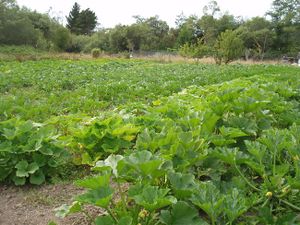
Dry farming is an approach to growing crops by utilizing moisture already present in the soil. If the geography allows it, dry farming is very low maintenance method of growing veggies. Crops we have successfully dry farmed have been beans, corn, squash, pumpkins, potatoes, and tomatoes. The Arcata Educational Farm, being a piece of land located in the low-lying coastal flood planes, dry farming methods are definitely compatible. When no irrigation is necessary, it vastly limits the amount of weed propagation as well as time spent watering. In the 2007 season we used the lowest lying piece of land for our dry farming area. Growing oodles of summer squash, winter squash, potatoes and pumpkins.
A Word on Soil Fertility[edit | edit source]
Establishing and maintaining a fertile soil is the way agriculture can remain sustainable. A healthy soil feeds healthy plants. Poor farming practices which exist treat the land as an empty medium in which chemicals are pumped into and out of. Heavy machinery is further separating the farmer from the land, causing a void of responsibility for the repercussions of degrading land stewarding practices. Top soil erosion, watershed pollution, soil compaction, desertification- all these problems and more are a daily reality which have direct roots in large scale input intensive agricultural systems. Its all been said before. My belief is that a healthy soil will support a healthy community. If the proper measures are taken to make sure the earth is fertile we avoid playing into the destructive cycles in place with-in the current system of operation. A healthy farm does not require inputs from abroad; instead it provides its own fertilization through composting and animal manure. Instead of pesticides, integrated pest management and a proper crop rotation that celebrates diversity limits unwanted diseases and garden critters. Using appropriate methods of irrigation can conserve resources, and save some water for our future. Many factors play into the degree to which a farm can sustain itself while providing healthy food to the community.
Cover Crops/Green Manures[edit | edit source]
One of the most efficient ways to maintain a healthy fertile farm is to plant crops which replenish important nutrients in the soil while maintaining a proper soil structure. Planting fields with cover crops over the winter serves a number of purposes, the most important being nitrogen fixation. Leguminous plants such as bell beans, vetch and clover bring nitrogen fixing bacteria back into the soil through root nodules. Nitrogen is the nutrient plants use the most of, so having a leguminous crop growing in the winter, when not much else can be grown, is an appropriate land use strategy. Cover crops are best cut down while they are flowering and worked into the soil before they produce a fruit/seed. This is important for two reasons. One is that in leguminous plants, the nitrogen is drawn out of soil and into the fruit. In other cover crops, if they are let go to seed one may have unwanted plant propagation issues. Once a cover crop is cut down the remains may either be removed and added to the compost or left in the fields; tilled under to break down. Removing the cover crop to a compost pile will allow one to be able to work a piece of land quicker than if the remains are left to be digested by the earth. However, letting the remains of the cover crop break down adds nutrients to the soil.

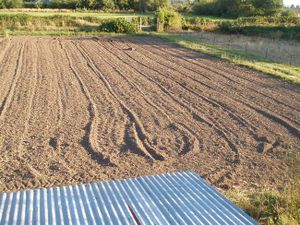
Cover crops can also play other important roles. In 2007 we experimented in using buckwheat as a method of weed prevention (a.k.a. smother crop). Once our winter cover crop was tilled under and broken down, we planted the buckwheat seed, watered and watched. With-in a week the buckwheat was already showing its first true leaves, and covering lots of space. Buckwheat grows so fast it shades out competing weeds. It is possible to till the buckwheat under, and promptly plant another round until the appropriate time for a winter cover. Other cover crops, such as oats and rye are used for their solid root masses to maintain a solid soil structure and hold in nutrients. Without a doubt, working cover crops into the yearly rotation can have its many benefits for replenishing soil fertility for a healthier farm.
Composting and Animal Manures[edit | edit source]

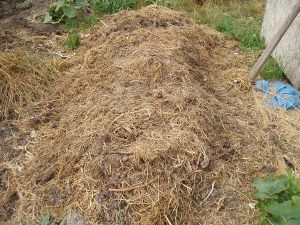
Other than using green manures, composting and animal manures also provide fertilization for a garden site. Composted animal manure is essential for a farm to be sustainable. However, in order to generate fertility on site with animals, a lot of space is needed. An ideal system has animals close at hand with a rotation between pasture land and farm land. At the Arcata Educational Farm this is not the case. The manure we have used has been trucked up north a couple miles from Loleta. We use composted goat manure in our fields as well as our compost pile. Although the goat manure helps provide a key source of fertility, shipping fertilizers onto a farm is less sustainable due to transportation loss and the fact that another piece of land is being used to keep soil fertile. A farm with integrated animal husbandry can be much more cyclical in terms of its fertilization inputs and veggie outputs.
Crop Rotation and Garden Planning[edit | edit source]
A fundamental pillar of sustainable agriculture is applying an effective crop rotation. Agricultural systems which promote diversity in the fields through the proper rotation crops are much more biologically stable. When planning for a garden, it is important to know the cultivated history of the land. Crops are rotated based on plant families. Information regarding plant families can usually be found on seed packets. By avoiding planting successive crops with similar biological demands, the cultivator is achieving two goals. One is a nutrient balance in the soil. Similar crops demand similar qualities from the soil (i.e. nitrogen, potassium, phosphorus, calcium, etc…). This example is best illustrated through the traditional European three-field agricultural system. This model rotates three crops in succession to maintain an appropriate nutrient balance. In one field a leguminous cover crop is planted to fix nitrogen. In another field, a crop which requires a lot of nitrogen (such as wheat or corn) is planted. In the last field, a tuber (i.e. potato, cassava, etc…) is planted. Tubers tend to draw on phosphorus and potassium instead of nitrogen. Each of these fields is then rotated in respective order each year. The nitrogen giver leading into the nitrogen taker leading to a potassium/phosphorus taker and back again to the nitrogen giver.
Another benefit to crop rotation is breaking up pest cycles and diseases. When a crop is grown in the same place year after year, pests are more likely to thrive in the familiar territory. Furthermore, when a disease such a fungus has been introduced into the soil, planting crops which are not susceptible helps restore order in the soil and maintain a healthy growing medium. The bottom line is that practicing a proper crop rotation increases the biological diversity in a garden space, thus attributing to a stronger healthier soil and subsequent stronger and healthier plants.
Planting Considerations[edit | edit source]
Deciding on what to plant where and when may seem to be a daunting task at first, but once several factors are taken into consideration it is much easier to develop an appropriate garden plan. Along with plant family, some important factors in garden planning are days to maturity, harvest periods, and heat and light requirements. Much of this information is available on certain seed packets. In our climate on the Humboldt Coast, it is possible to harvest vegetables all year round. Storage crops such as beets, carrots, cabbage, winter squash, brussel sprouts, rutebega (and more) can be planted in late summer for a winter harvest. Also, leafy greens such as kale, chard, and lettuce can be grown outside overwinter.
For a planting guide of the Humboldt Coast, check out the Humboldt Coast Planting Guide, developed by Eddie Tanner, a local farmer with many years of experience farming on the Humboldt Coast. This guide is gold. The planting guide is roughly organized by plant families, with shaded regions indicating the available window for planting the desired vegetable crop. Note the key at the bottom of the planting guide which explains whether a crop should be direct sown, transplanted, the time needed for an appropriate succession, heat requirements, and frost intolerance.
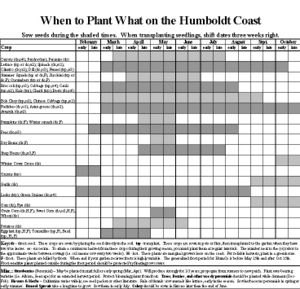
Conclusion[edit | edit source]
As stated in the introduction, learning how to garden and grow vegetables in a sustainable manner is an evolving process. There are so many intricacies involved that only experience can provide you with. I have found the hardest but most effective way I have gained knowledge about vegetable production has been through trial and error. Failing has succeeded in teaching me my most valuable lessons. I realize that if it wasn't for the evolution of agriculture, the world as it exists in the current time and space would be drastically different. It is my personal belief that irresponsible methods of agricultural production which currently exist jeopardize the health of our communities and our future. Growing food on a local and sustainable level is a way to build strong bonds with our community and gives us hope in the face of inevitable changes dawning on the horizon.
Photo Gallery[edit | edit source]
Additional pictures of the Arcata Educational Farm.





















